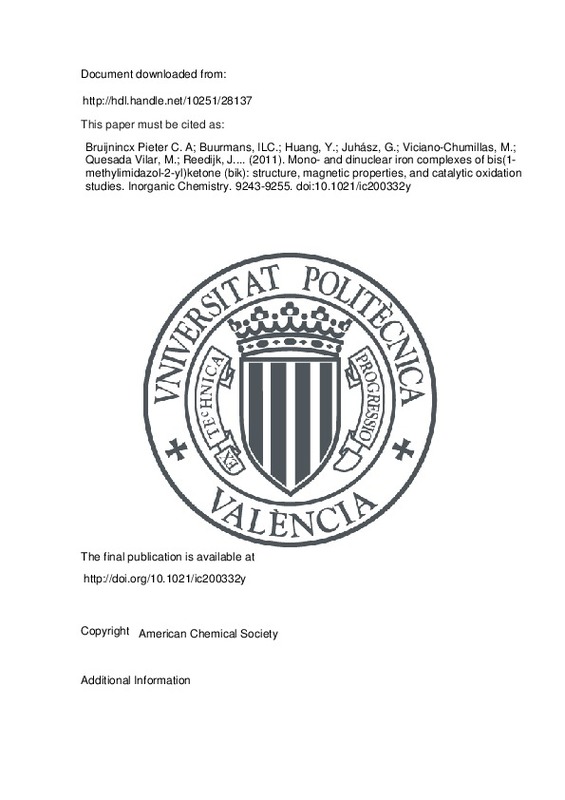JavaScript is disabled for your browser. Some features of this site may not work without it.
Buscar en RiuNet
Listar
Mi cuenta
Estadísticas
Ayuda RiuNet
Admin. UPV
Mono- and dinuclear iron complexes of bis(1-methylimidazol-2-yl)ketone (bik): structure, magnetic properties, and catalytic oxidation studies
Mostrar el registro sencillo del ítem
Ficheros en el ítem
| dc.contributor.author | Bruijnincx Pieter C. A
|
es_ES |
| dc.contributor.author | Buurmans, Inge L. C
|
es_ES |
| dc.contributor.author | Huang, Yuxing
|
es_ES |
| dc.contributor.author | Juhász, Gergely
|
es_ES |
| dc.contributor.author | Viciano-Chumillas, Marta
|
es_ES |
| dc.contributor.author | Quesada Vilar, Manuel
|
es_ES |
| dc.contributor.author | Reedijk, Jan
|
es_ES |
| dc.contributor.author | Lutz, Martin
|
es_ES |
| dc.contributor.author | Spek, Anthony L.
|
es_ES |
| dc.contributor.author | Munck, Eckard
|
es_ES |
| dc.contributor.author | Bominaar, Emile L.
|
es_ES |
| dc.contributor.author | Klein Gebbink, Robertus J. M.
|
es_ES |
| dc.date.accessioned | 2013-04-23T10:52:47Z | |
| dc.date.issued | 2011-09-08 | |
| dc.identifier.issn | 0020-1669 | |
| dc.identifier.uri | http://hdl.handle.net/10251/28137 | |
| dc.description.abstract | [EN] The newly synthesized dinuclear complex [Fe-2(III)(mu-OH)(2)(bik)(4)](NO3)(4) (1) (bik, bis(1-methylimidazol-2-yl)ketone) shows rather short Fe center dot center dot center dot Fe (3.0723(6) angstrom) and Fe-O distances (1.941(2)/1.949(2) angstrom) compared to other unsupported Fe-2(III)(mu-OH)(2) complexes. The bridging hydroxide groups of 1 are strongly hydrogen-bonded to a nitrate anion. The Fe-57 isomer shift (delta = 0.45 mm s(-1)) and quadrupole splitting (Delta E-Q = 0.26 mm s(-1)) obtained from Mossbauer spectroscopy are consistent with the presence of two identical high-spin iron(III) sites. Variable-temperature magnetic susceptibility studies revealed antiferromagnetic exchange (J = 35.9 cm(-1) and H = JS(1).S-2) of the metal ions. The optimized DFT geometry of the cation of 1 in the gas phase agrees well with the crystal structure, but both the Fe center dot center dot center dot Fe and Fe-OH distances are overestimated (3.281 and 2.034 angstrom, respectively). The agreement in these parameters improves dramatically (3.074 and 1.966 angstrom) when the hydrogen-bonded nitrate groups are included, reducing the value calculated for J. by 35%. Spontaneous reduction of 1 was observed in methanol, yielding a blue [Fe-II(bik)(3)](2+) species. Variable-temperature magnetic susceptibility measurements of [Fe-II(bik)(3)](OTf)(2) (2) revealed spin-crossover behavior. Thermal hysteresis was observed with 2, due to a loss of cocrystallized solvent molecules, as monitored by thermogravimetric analysis. The hysteresis disappears once the solvent is fully depleted by thermal cycling. [Fe-II(bik)(3)](OTf)(2) (2) catalyzes the oxidation of alkanes with t-BuOOH. High selectivity for tertiary C-H bond oxidation was observed with adamantane (3 degrees/2 degrees value of 29.6); low alcohol/ketone ratios in cyclohexane and ethylbenzene oxidation, a strong dependence of total turnover number on the presence of O-2, and a low retention of configuration in cis-1,2-dimethylcyclohexane oxidation were observed. Stereoselective oxidation of olefins with dihydrogen peroxide yielding epoxides was observed under both limiting oxidant and substrate conditions. | es_ES |
| dc.description.sponsorship | This work was financially supported by the National Research School Combination-Catalysis (P.C.A.B.), the Council for Chemical Sciences of The Netherlands Organization for Scientific Research (CW-NWO) (M.L. and A.L.S.), and the National Institutes of Health Grant EB-001475 (E.M.). Dr. Stefania Tanase-Grecea is kindly acknowledged for her help with the collection of the magnetic measurements. Part of the work was financially supported the EC-RTN "QuEMolNa" (No. MRTN-CT-2003-504880) and the EC Network of Excellence "MAG-MANet" (No. 515767-2). | |
| dc.language | Inglés | es_ES |
| dc.publisher | American Chemical Society | es_ES |
| dc.relation.ispartof | Inorganic Chemistry | es_ES |
| dc.rights | Reserva de todos los derechos | es_ES |
| dc.subject | 2-HIS-1-carboxylate facial | es_ES |
| dc.subject | Bridged diiron(III) complexes | es_ES |
| dc.subject | Alkane oxidation | es_ES |
| dc.subject | Biomimetic nonheme iron | es_ES |
| dc.subject | Crystal-structures | es_ES |
| dc.subject | Ribonucleotide reductase | es_ES |
| dc.title | Mono- and dinuclear iron complexes of bis(1-methylimidazol-2-yl)ketone (bik): structure, magnetic properties, and catalytic oxidation studies | es_ES |
| dc.type | Artículo | es_ES |
| dc.embargo.lift | 10000-01-01 | |
| dc.identifier.doi | 10.1021/ic200332y | |
| dc.relation.projectID | info:eu-repo/grantAgreement/EC/FP6/515767/EU/Molecular approach to nanomagnets and multifunctional materials/MAGMANET/ | es_ES |
| dc.relation.projectID | info:eu-repo/grantAgreement/EC/FP6/504880/EU/Quantum Effects in Molecular Nanomagnets/QUEMOLNA/ | es_ES |
| dc.relation.projectID | info:eu-repo/grantAgreement/NIH//001475/ | es_ES |
| dc.rights.accessRights | Abierto | es_ES |
| dc.contributor.affiliation | Universitat Politècnica de València. Instituto Universitario Mixto de Tecnología Química - Institut Universitari Mixt de Tecnologia Química | es_ES |
| dc.description.bibliographicCitation | Bruijnincx Pieter C. A; Buurmans, ILC.; Huang, Y.; Juhász, G.; Viciano-Chumillas, M.; Quesada Vilar, M.; Reedijk, J.... (2011). Mono- and dinuclear iron complexes of bis(1-methylimidazol-2-yl)ketone (bik): structure, magnetic properties, and catalytic oxidation studies. Inorganic Chemistry. 9243-9255. https://doi.org/10.1021/ic200332y | es_ES |
| dc.description.accrualMethod | S | es_ES |
| dc.relation.publisherversion | http://doi.org/10.1021/ic200332y | es_ES |
| dc.description.upvformatpinicio | 9243 | es_ES |
| dc.description.upvformatpfin | 9255 | es_ES |
| dc.type.version | info:eu-repo/semantics/publishedVersion | es_ES |
| dc.relation.senia | 193911 | |
| dc.identifier.pmid | 21902227 | |
| dc.identifier.pmcid | PMC3221465 | |
| dc.contributor.funder | National Institutes of Health, EEUU | |
| dc.contributor.funder | European Commission | |
| dc.contributor.funder | Dutch National Research School Combination Catalysis Controlled by Chemical Design | |
| dc.contributor.funder | Netherlands Organization for Scientific Research |







![[Cerrado]](/themes/UPV/images/candado.png)

